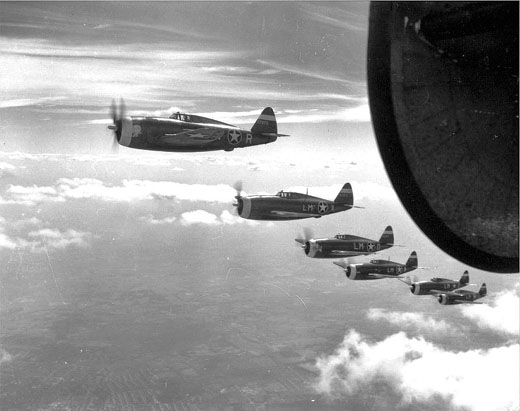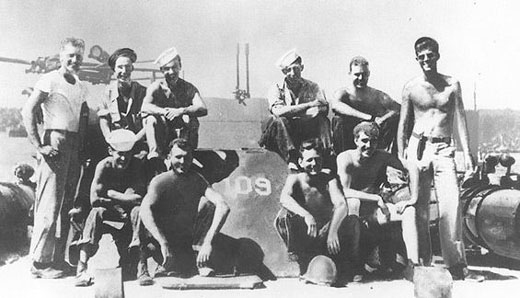Air Operations, Aleutians
11 28th Composite Bomb Group B-24s, 10 of 15 B-25s dispatched, 21 343rd Fighter Group P-38s, 12 P-40s, and 24 RCAF P-40s mount 15 separate missions against Kiska.
Air Operations, Bismarcks
1 B-17 of the 43rd Heavy Bomb Group attacks Arawe, Gasmata, and Ubili.
[Air Operations, CBI
BURMA- 7 7th Heavy Bomb Group B-24s attack warehouses near Rangoon and 7 other B-24s attack the oil refinery at Thilawa.
- 10 341st Medium Bomb Group B-25s attack the airfield at Heho.
- 10 B-25s attack the airfield at Kanaung.
- Following a week-long program of feints against the airfield at Yunnanyi that resulted in no bombs being dropped, 12 Japanese bombers and 15 fighters catch 20 P-40s of the 23rd Fighter Groupís 74th Fighter Squadron waiting on the ground. 5 P-40s and a C-47 are demolished in the attack, 15 P-40s are damaged, and 5 USAAF personnel are killed.
- 1 P-40 from the 23rd Fighter Group downs a Ki-21 'Sally' bomber over Shinshiku.
Air Operations, Europe
BOMBER COMMANDDaylight Ops:
- 6 Mosquitos attack railway targets at Tours, Jülich and Trier without a loss.
- 561 aircraft attack Duisburg. Included in the total are 215 Lancasters, 135 Wellingtons, 119 Halifaxes, 78 Stirlings and 14 Mosquitos.
- This heavy raid is a partial failure. The Pathfinders claim to have marked the target correctly but later daytime reconnaissance photos show that most of the bombing falls to the northeast of Duisburg. The Main Force may have bombed to early or lured by early fires short of the target. However, more that 300 buildings are destroyed in Duisburg and the death toll from conflicting report is between 130 and 207. Bombs are reported to have hit 6 other towns in the Ruhr.
- 7 Halifaxes, 5 Wellingtons, 3 Lancasters and 2 Stirlings are lost.
- 8 OTU aircraft drop leaflets over France without a loss.
P-47 Thunderbolts of the 56th Fighter Group |
 |
Air Operations, Mediterranean
- NASAF B-26s and P-38 escorts attack Axis shipping at sea near Marettimo Island and Porto Ponte Romano, Sardinia.
- NATBF B-25s attack Axis ships at sea off Cap Bon.
Air Operations, New Guinea
90th Heavy Bomb Group B-24s attack Finschhafen and Lae.
[Air Operations, Tunisia
- NASAF B-25s attack the rail line at Mateur and the town of Teboura.
- NATBF A-20s and B-25s attack numerous targets, including transportation targets throughout the battle area in northeast Tunisia.
- 31st Fighter Group Spitfire pilots down 5 Bf-109s in the course of several aerial engagements over the battle area between 1105 and 1400 hours.
Aleutians
The Japanese-held harbors on Attu, Chicagof(?) Harbor and Holtz Bay, are bombarded by an American squadron led by Rear-Adm C. H. McMorris. The squadron consists of 3 cruisers and 6 destroyers.
[Diplomatic Relations
The Russians break off relations with the Polish government-in-exile because of the allegations concerning the Katyn massacre. Relations have been poor for some time in any case as Stalin's attitude toward a post-war Poland has become more clear. On Apr 30 in an attempt to patch up the quarrel, the Poles drop the call for a Red Cross enquiry.
Moscow breaks off relations with the Polish government-in-exile in London and recognizes the Union of Polish Patriots as the official representatives of the Polish people. This organization comprises Polish communists resident in the USSR and under the control of Moscow.
[India, Home Front
- Pres Roosevelt's personal representative complains that the Viceroy has refused him permission to see imprisoned Gandhi.
- The Moslem Conference demands the creation of 'Pakistan' as the only means of preventing bloodshed.
Indian Ocean
U-180 meets I-29 near Mauritius and transfers Subhas Chandra Bose, pro-Axis Indian nationalist en route form Berlin to Penang, Malaya.
[North Africa
TUNISIA'Longstop Hill' is taken by British V Corps who reach Djebel Bou Aoukaz, much aided by the excellent cross-country performance of their Churchill tanks.
On the US II Corps' 9th Div front, the 60th Regimental Combat Team swings to the northeast toward Kef en Nsour, the previous objective of the Corps Franc D'Afrique, rather that to the southeast toward the Jefna position as planned, since the French are unable to advance in the region north of Djebel Dardyss. The 39th Regimental Combat Team, now solely responsibility for outflanking the Jefna position, takes Hill 513, southeast of Djebe Aïnchouna. Continuing a holding action along the highway, the 47th Regimental Combat Team finds the enemy disposed in force on Hill 598, southwest of Djebel Ajred. The 34th Div takes over the in the Djebel Grembil-Hill 575 region, between the 9th And 1st Divs, and prepares for a drive on Hill 609 (Djebel Tahent). The enemy positions on the hills in this area are being softened by artillery fire. On the southern flank, the 1st Div gains its initial objectives, permitting the 1st Armored Div to take over the Tine valley zone at 2200 in preparation for an armored drive through the enemy's second line of defense to Mateur.
In the British 1st Army's V Corps area, the 78th Div finishes clearing Djebel el Ahmera. The 1st Div reaches Djebel Bou Aoukaz, 4 miles from Djebel el Ahmera. On the main road to Tunis, the 4th Div reaches positions 7 miles east of Medjez el Bab. The IX Corps is now opposed on the Goubellat plain by 3 enemy armored divisions that contain further efforts to advance. The 6th Armored Div is withdrawn into reserve. The French XIX Corps continues to pursue the enemy northward toward Pont-du-Fahs, reaching Djebel Fkirine.
[South Pacific
New plans are agreed for the American Solomon Islands operations, code named CARTWHEEL replacing ELKTON. Halsey's. South Pacific Area forces are to advance through New Georgia and Bougainville. MacArthur's Southwest Pacific Area is to continue its advance northwest along the coast of New Guinea until he and Halsey can join to isolate the Japanese bases at Rabaul and Kavieng.
Lt John F. Kennedy and PT-109 |
 |